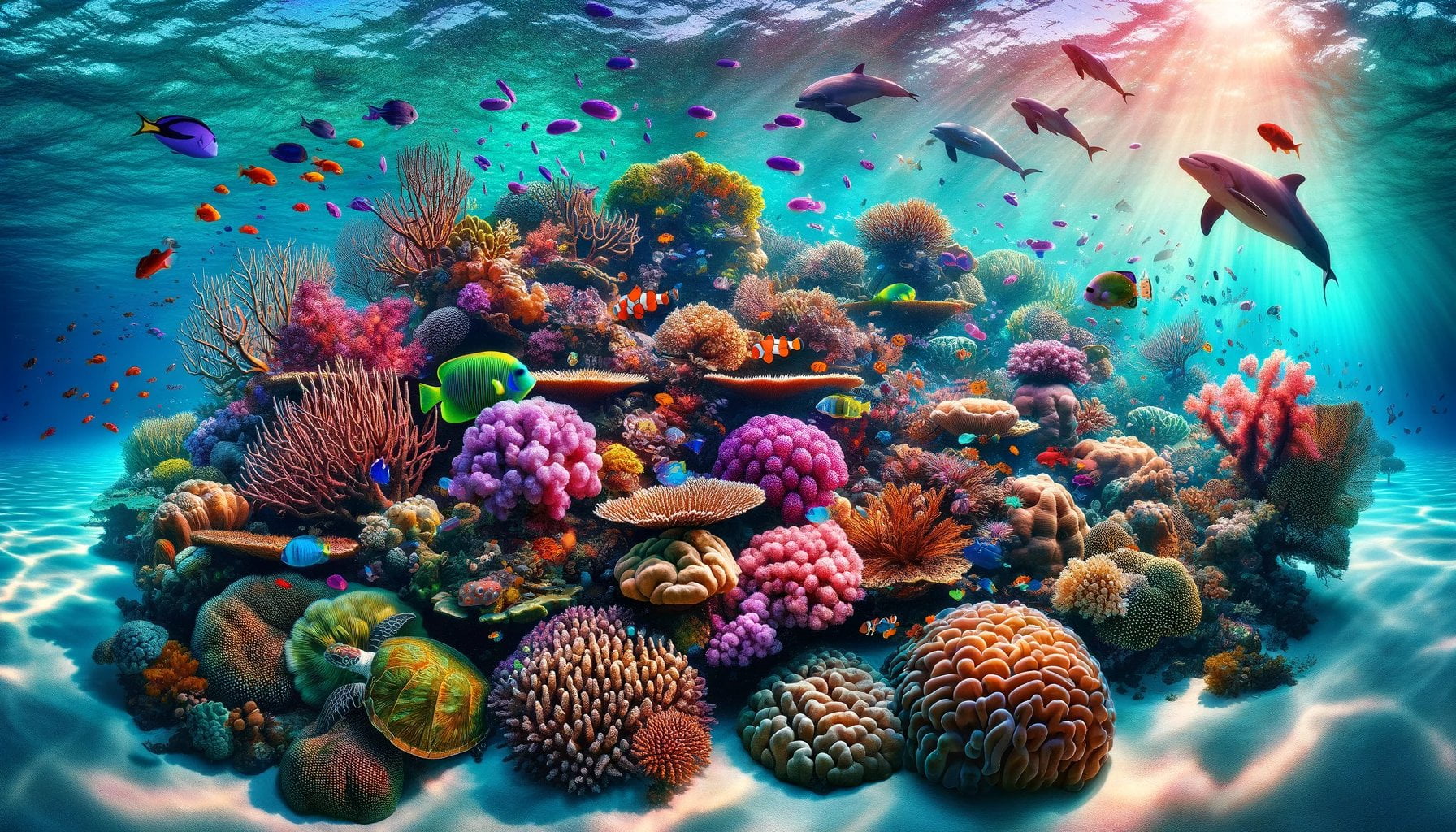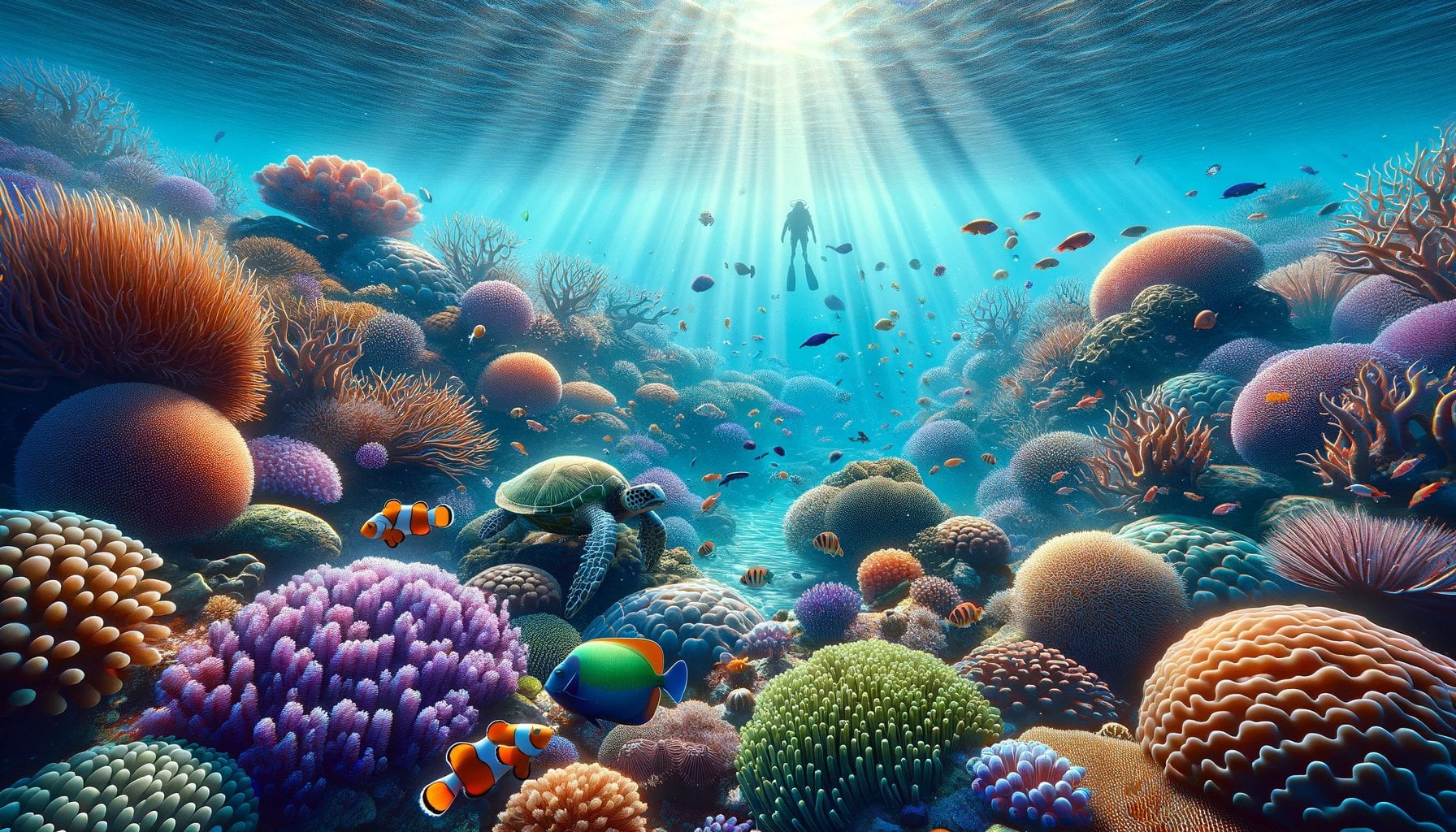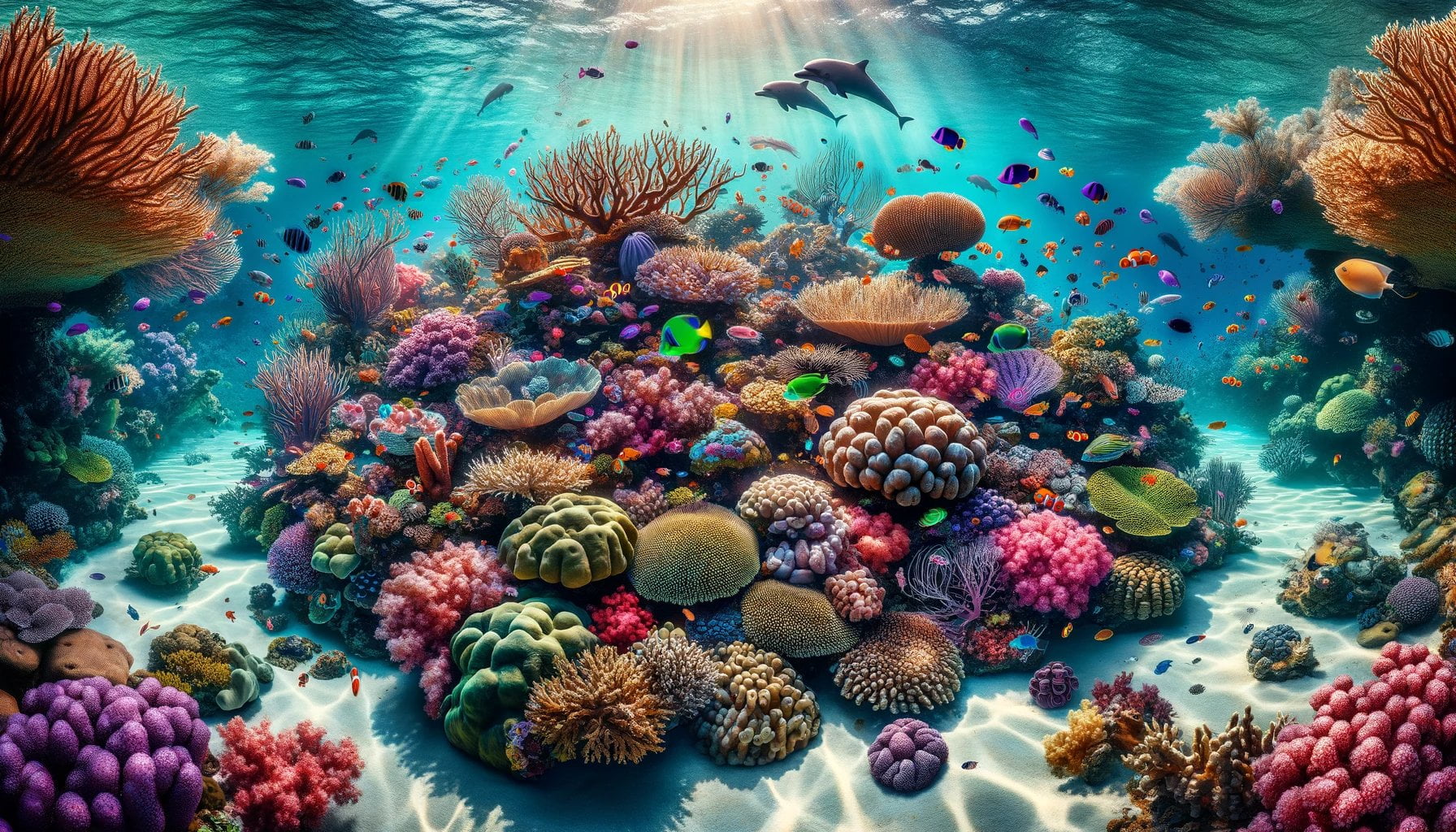Unveiling the Wonders: 10 Fascinating Facts About Coral Reefs takes readers on an immersive journey into the captivating world of these stunning underwater ecosystems. Revealing the growing threats facing coral reefs, the incredible diversity of species they harbor, the living nature of corals themselves, and their status as the most biodiverse ecosystem on the planet, this article offers a mesmerizing blend of scientific expertise and storytelling prowess. Prepare to be amazed as you delve into the secrets and marvels that make coral reefs such extraordinary and vital parts of our natural world.
Key Takeaways:

- Coral reefs have been around for millions of years and require sunlight to grow.
- There are various types of coral reefs, each with its own unique characteristics.
- Coral reefs play a significant role in cleaning up their surrounding water environments.
- Over 4,000 fish species depend on coral reefs for their survival.
- Coral reefs help stabilize the seabed and provide essential habitats for countless marine organisms.
- The Great Barrier Reef is the largest coral reef in the world.
- Half a billion people rely on coral reefs as a source of food.
- Coral, like trees, have growth rings that provide insights into their age and development.
- The first coral reefs formed on Earth approximately 240 million years ago.
- Most coral reefs today are between 5,000 and 10,000 years old.
- There are over 800 different types of hard coral found worldwide.
10 Interesting Facts About Coral Reefs
The underwater realm of coral reefs is a treasure trove of fascinating discoveries. Let’s dive into the enchanting world of these marine wonders and uncover ten captivating facts:
1. Coral Reefs: Ancient Marvels
Coral reefs have stood the test of time, existing for millions of years^1^. These ancient marvels have evolved and thrived, shaping our oceans with their delicate beauty.
2. Sunlight Nourishes the Reef
Just like plants, coral reefs require sunlight to flourish^1^. Through a process called photosynthesis, the algae living within coral polyps convert sunlight into energy, providing nourishment for the entire ecosystem.
3. Diversity in Coral Reef Types
Coral reefs come in various forms, each with its own distinct characteristics and inhabitants^1^. From fringing reefs close to the shorelines to barrier reefs and atolls, these diverse structures add a mesmerizing touch to our underwater landscapes.
4. Nature’s Water Purifiers
Coral reefs perform an important service for the underwater environment—they act as natural water purifiers^1^. Filtering out pollutants and excess nutrients, they play a crucial role in maintaining the health and balance of their surrounding waters.
5. A Haven for Marine Life
Over 4,000 fish species rely on coral reefs for their survival and habitat^1^. These vibrant ecosystems provide shelter, breeding grounds, and sources of food for an incredible array of marine creatures.
6. Foundation Builders
Coral reefs not only showcase stunning biodiversity but also stabilize the sea bed^1^. As corals grow and form skeletal structures, they create a foundation that supports countless organisms, including sponges, sea anemones, and crustaceans.
7. The Great Barrier Reef: A Natural Wonder
The Great Barrier Reef stands as the world’s largest coral reef^1^. Stretching over 2,300 kilometers along Australia’s northeastern coast, it is a breathtaking UNESCO World Heritage site, brimming with awe-inspiring marine life.
8. Lifeline for Coastal Communities
Coral reefs are more than just spectacular sights; they are a lifeline for millions of people who depend on them for sustenance^1^. Approximately half a billion individuals rely on coral reefs as a vital source of food, supporting local economies and livelihoods.
9. Growth Rings for Coral
Similar to the growth rings found in trees, coral skeletons develop annual bands that provide insight into their age and history^1^. These growth rings help us understand the lifespan and growth patterns of these ancient organisms.
10. A Journey Back in Time
The first coral reefs emerged on Earth approximately 240 million years ago^1^. These ancient structures serve as a window to our planet’s past, offering glimpses into the evolution and transformation of our oceans over millennia.
Coral reefs are truly extraordinary ecosystems that captivate our imagination with their sheer beauty and ecological significance. These ten fascinating facts are just the tip of the iceberg when it comes to the wonders that await beneath the waves.
So, let’s continue to explore, protect, and celebrate these delicate underwater realms, unearthing the secrets they hold for generations to come.
Sources:
Check out these fascinating 10 facts about the Great Barrier Reef!
You won’t believe the incredible secrets surrounding the Arctic fox.
Get ready to dive into the wonders of coral reefs and discover the most captivating 10 interesting facts about them!
Corals are alive
Did you know that corals are actually living animals? That’s right, they are not plants as many people may think. Corals belong to a group of animals called cnidarians, which also includes jellyfish and sea anemones. These fascinating creatures come in a variety of shapes, sizes, and colors, and can be found in tropical and subtropical waters all around the world.
Here are 10 interesting facts about coral reefs that highlight the fact that corals are indeed alive:
- Coral reefs are home to a quarter of all marine species[^1^]. The intricate structure of the reefs provides shelter, food, and breeding grounds for countless marine organisms, making coral reefs highly biodiverse and vibrant ecosystems.
- Corals are animals, not plants[^1^]. They may look like colorful plants, but corals are actually made up of thousands of tiny polyps, which are soft-bodied organisms that secrete a hard exoskeleton made of calcium carbonate. These polyps work together to build the beautiful coral colonies we see underwater.
- Half a billion people rely on coral reefs for food[^1^]. Coral reefs are a vital source of protein for many coastal communities around the world. They support local fisheries and provide livelihoods for millions of people.
- Coral reefs need sunlight to grow, but too much heat can be harmful[^1^]. Corals have a symbiotic relationship with tiny algae called zooxanthellae, which live within their tissues and provide them with energy through photosynthesis. If the water temperature gets too high, corals expel the algae, leading to coral bleaching and potentially death.
- They act as a barrier during storms[^1^]. Coral reefs serve as natural breakwaters, helping to protect coastlines from the destructive force of waves and storms. They absorb and dissipate much of the energy from incoming waves, reducing the impact on coastal communities.
- Coral reefs clean the water they’re in[^1^]. The intricate structure of coral reefs acts as a natural filter, trapping sediments and pollutants and improving water clarity. This helps to maintain the overall health of the marine ecosystem.
- They are a huge driver of tourism[^1^]. Coral reefs are a major attraction for scuba divers, snorkelers, and nature enthusiasts. The beauty and diversity of coral reefs draw millions of visitors each year, providing economic benefits to local communities and countries.
- Coral reefs cover only 0.1% of the oceans’ total area[^2^]. Despite their relatively small coverage, coral reefs play a crucial role in supporting marine life and contributing to the overall health of the oceans.
- The world’s coral reefs have an economic value of at least $30 billion[^2^]. This includes revenue generated from tourism, fisheries, and other industries that depend on coral reefs. Protecting and conserving these ecosystems is not only important for their ecological value but also for sustainable economic development.
- The Great Barrier Reef is the largest reef system on Earth[^3^]. Located off the northeast coast of Australia, the Great Barrier Reef stretches over 2,300 kilometers and is visible from space. It is not only a UNESCO World Heritage site but also a global icon of natural beauty.
Key Takeaways:
– Coral reefs are living animals called cnidarians.
– They support a quarter of all marine species and provide vital resources for half a billion people.
– Coral reefs rely on sunlight for growth, but high temperatures can lead to bleaching and death.
– They act as natural barriers, clean the surrounding water, and drive tourism and economic growth.
– Despite covering only a small portion of the ocean, coral reefs are of immense ecological and economic value.
– The Great Barrier Reef is the largest and most famous coral reef system on Earth.
Learn more about coral reefs at:
Coral Reefs: The Most Biodiverse Ecosystem
Key Takeaways:
- Coral reefs are the most biodiverse ecosystems on Earth, even surpassing tropical rainforests in terms of diversity.
- These underwater wonders provide habitat for numerous species of fish, corals, and other marine life.
- Coral reefs offer various ecosystem services, including coastal protection, fisheries, tourism, recreation, and potential sources of medicine.
- The Bird’s Head Peninsula coral reef in West Papua is recognized as the most biodiverse region of the world’s oceans.
Coral reefs are a true marvel of nature, teeming with life and vibrancy beneath the ocean’s surface. In fact, they are the most biodiverse ecosystems on our planet, boasting an incredible array of species and playing a vital role in maintaining the balance of marine life.
With a higher level of biodiversity than even tropical rainforests, coral reefs provide refuge to an astonishing variety of creatures. From the tiniest colorful fish to the majestic sea turtles and the intricate and delicate corals themselves, these ecosystems harbor an astounding number of species, each with its own unique role to play.
Beyond their sheer beauty and biological importance, coral reefs offer a host of vital ecosystem services. These underwater havens provide coastal protection, acting as natural barriers that shield coastlines from the damaging impact of storms and waves. Additionally, they support thriving fisheries, providing sustenance and livelihoods for countless communities worldwide.
Coral reefs are also a magnet for tourism, drawing in visitors who are captivated by the breathtaking underwater landscapes and the chance to witness the remarkable diversity of marine life. The economic value of coral reefs is astronomical, contributing billions of dollars annually to local economies. Furthermore, these ecosystems hold immense potential as sources for medicine, with researchers continuously uncovering the healing properties of underwater organisms.
When it comes to the crown jewel of biodiversity in coral reefs, the Bird’s Head Peninsula coral reef in West Papua takes center stage. This region, with its crystal-clear waters and vibrant coral gardens, has been identified as the most biodiverse spot in the world’s oceans. The sheer number of species that call this area home is awe-inspiring, and it serves as a testament to the rich tapestry of life that coral reefs can support.
In conclusion, coral reefs are an unparalleled example of the extraordinary biodiversity found on our planet. Their importance cannot be overstated, as they provide critical habitat, ecosystem services, and economic benefits. By recognizing and appreciating the exceptional diversity of coral reefs, we can work towards their conservation and ensure that these underwater wonders continue to thrive for generations to come.
Sources:
– Reef-World Foundation – Surprising Coral Facts
– National Geographic – Coral Reefs

FAQ
Q1: What are some growing threats to coral reefs?
A1: Some growing threats to coral reefs include pollution, overfishing, climate change, ocean acidification, and coral bleaching.
Q2: How diverse is the species found in coral reefs?
A2: Coral reefs are home to an incredible diversity of species, with estimates suggesting that they support over a quarter of all marine species in the world.
Q3: Are corals alive?
A3: Yes, corals are alive. They are actually animals, not plants, and are made up of tiny polyps that form colonies and build the intricate structures of coral reefs.
Q4: Why are coral reefs considered the most biodiverse ecosystem?
A4: Coral reefs are considered the most biodiverse ecosystem because they host a wide variety of organisms. They provide habitat for numerous species of fish, corals, and other marine life, making them incredibly rich in biodiversity.
Q5: What makes coral reefs so fascinating?
A5: Coral reefs are fascinating due to their intricate and vibrant ecosystems. They not only offer various ecosystem services such as coastal protection, fisheries, and tourism but also serve as a potential source of medicine. Additionally, they are often referred to as the “rainforests of the sea” because of their high diversity, resembling the biodiversity found in tropical rainforests.
- Senior at What Age: Benefits & Eligibility Guide - March 29, 2025
- Unlocking Senior Benefits: How Old is a Senior? Your Complete Guide - March 29, 2025
- Master Russian Politeness:A Guide to Saying Please - March 29, 2025
















